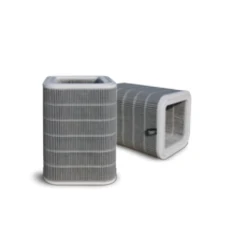Features and considerations related to electrostatic filters
2023-12-11
Electrostatic filters, also known as electrostatic air filters or electronic air cleaners, are types of air filters that use an electrostatic charge to trap particles as air flows through them. These filters are commonly used in heating, ventilation, and air conditioning (HVAC) systems to improve indoor air quality. Here are key features and considerations related to electrostatic filters:
Characteristics of Electrostatic Filters:
1. Charging Mechanism:
- Electrostatic filters use an electric charge to attract and capture particles. The filter material is typically charged with static electricity, and as air passes through, particles become charged and adhere to the filter.
2. Reusable and Washable:
- Many electrostatic filters are reusable and washable. Users can clean them by rinsing or vacuuming, which can extend their lifespan compared to disposable filters.
3. Particle Capture:
- Electrostatic filters are effective at capturing a range of particles, including dust, pollen, pet dander, and some bacteria. They can be particularly efficient at trapping smaller particles.
4. Silent Operation:
- Electrostatic filters operate silently because they don't have moving parts or fans. This can be an advantage for those who prefer a quiet environment.
5. Complement to Other Filters:
- Electrostatic filters are sometimes used in conjunction with other filtration technologies, such as pre-filters or activated carbon filters, to provide comprehensive air purification.
6. Low Airflow Resistance:
- Compared to some traditional filters, electrostatic filters may have lower airflow resistance, allowing HVAC systems to operate more efficiently.
Considerations:
1. Effectiveness on Larger Particles:
- Electrostatic filters are generally more effective at capturing larger particles than smaller ones. While they can capture smaller particles, their efficiency may vary.
2. Ozone Emission:
- Some electronic air cleaners can produce small amounts of ozone as a byproduct. It's important to choose models with low or no ozone emission, especially if there are concerns about indoor air quality.
3. Maintenance:
- Regular cleaning is essential for maintaining the effectiveness of electrostatic filters. Check the manufacturer's recommendations for cleaning intervals and methods.
4. Effect on Allergens:
- Electrostatic filters can be effective in reducing airborne allergens, but they may not capture all types of allergens, particularly those that are very small.
5. Initial Cost:
- The initial cost of electrostatic filters may be higher than that of traditional disposable filters. However, their reusability can offset long-term costs.
6. Placement and Sizing:
- Proper sizing and placement of electrostatic filters within the HVAC system are crucial for optimal performance. Follow the manufacturer's guidelines for installation.
7. Effect on Smoke:
- Electrostatic filters can be effective in capturing smoke particles and some odors. However, for comprehensive smoke removal, specialized filters may be more suitable.
8. Effect on Microorganisms:
- While electrostatic filters can capture some bacteria and viruses, they may not be as effective as other technologies, such as HEPA filters or UV-C light, for addressing microbial contaminants.
When considering electrostatic filters for air purification, it's important to evaluate their effectiveness in capturing specific particles, their maintenance requirements, and any potential drawbacks such as ozone emission. Regular cleaning and proper maintenance are crucial for ensuring optimal performance over time.



